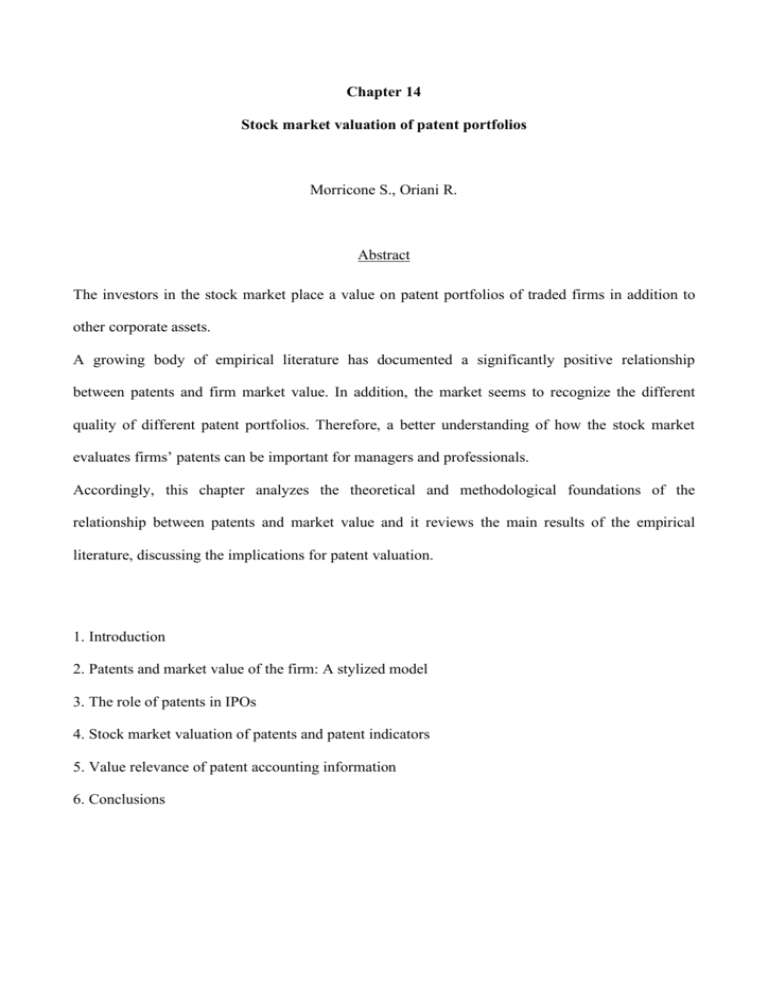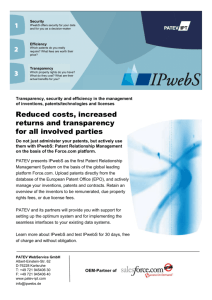Outline Chapter 14
advertisement

Chapter 14 Stock market valuation of patent portfolios Morricone S., Oriani R. Abstract The investors in the stock market place a value on patent portfolios of traded firms in addition to other corporate assets. A growing body of empirical literature has documented a significantly positive relationship between patents and firm market value. In addition, the market seems to recognize the different quality of different patent portfolios. Therefore, a better understanding of how the stock market evaluates firms’ patents can be important for managers and professionals. Accordingly, this chapter analyzes the theoretical and methodological foundations of the relationship between patents and market value and it reviews the main results of the empirical literature, discussing the implications for patent valuation. 1. Introduction 2. Patents and market value of the firm: A stylized model 3. The role of patents in IPOs 4. Stock market valuation of patents and patent indicators 5. Value relevance of patent accounting information 6. Conclusions Offprint from Paragraph 5 Value relevance of patent information As shown in previous paragraph, the stock market valuation of patents based on Tobin’s Q relates patents measures to the market value of the firm measured relative to tangible assets. In this section we present an alternative empirical model based on the value relevance that focuses on the information content of patents. The studies on Tobin’s Q reviewed in paragraph 4 are interested in the factors affecting the market valuation of innovation, as measured by patents and patents indicators. On the contrary, the studies on value relevance use stock market values as informative benchmark in order to understand whether patents information is reflected into firm value effectively and timely (Barth, 2000). The main assumption of value relevance studies is that patents statistics contain information useful to investors above and beyond accounting values. Accordingly, patents data are value relevant, i.e., have a predicted significant relation with share prices, only if these values convey information relevant to investors in evaluating the firm and is reflected in share prices (Beaver, 1998; Barth, 2000; Barth et al., 2001; Holthausen & Watts, 2001). Most of studies on the value relevance of patents stem their motivations from the problems related to the accounting valuation discussed in chapter 13. In particular, value relevance studies use patents statistics as nonfinancial indicators in order to prove the information deficiency of financial statements. Then, for high-tech firms investors may need to supplement accounting information with nontraditional data that helps them form better estimates of the future profit-making potential of the firm’s scientific endeavors (Hirschey & Richardson, 2001a). The implications of these studies suggest that a consistent footnote disclosure on patent information would increase the informativeness of financial statement for high-tech firms. The studies that have analysed the association between patents statistics and stock market could be distinguished with respect to the period of analysis and the methodology (Lev and Sougiannis, 1996; Holthausen & Watts, 2001). Contemporaneous studies or price models analyse the association between patents information and current stock prices and indicate the extent of information content of patents by investors. Intertemporal studies or return models evaluate the relationship between patents information and future stock returns in order to investigate whether patents attributes are able to predict future company performance. Marginal information content studies or event studies investigate whether patents add to the information set available to investors. They aim at determining if the release of patent related information is associated with value changes and price reactions are considered evidence of value relevance (Holthausen & Watts, 2001). As concerns contemporaneous studies, the empirical findings document that patents statistics represent on average relevant information for investors. For example, the work of Hirschey, Richardson and Scholz (2001) is one of the first contributions on empirical market-based research seeking evidence on the value relevance of patent data through analyses of the relation between such information and the value of the firm. Using different citations-based indicators of scientific merit as measures of patent quality, Hirschey and colleagues (2001) have extended the historical evidence on the link between the market value of the firm and the number of patents by showing the value relevance of patent quality tied to R&D investments. Specifically, they have analysed the value relevance of patent quality through two indicators: the Current Impact Index is an indicator of patent portfolio quality and is measured by the number of times a company’s previous five years of patents are cited in the current year, relative to all patents in the U.S. patent system; the indicator Technology Cycle Time indicates the speed of innovation and is defined as the median age in years of the U.S. patent references cited on the front page of company patents. Their finding have shown that patent quality appear to give investors a more useful basis upon which to judge the economic merit of the firm’s R&D effort. In particular, patent portfolio quality has a robust positive influence on valuation effects tied to R&D. This suggests that investors are able to perceive a positive relation between the scientific merit of patent output and the value created by R&D expenditures. Conversely, there is a negative influence of speed of innovation on the market value effects of R&D expenditures. In a related study, Hirschey and Richardson (2001a) have provided evidence on the market value implications of inventive and innovative output by studying the association between stock prices and patent quality for firms of varying sizes and growth opportunities.i They have found that especially in the case of small cap and relatively low P/E high tech companies there is a favorable association between stock prices and the number of patents and the scientific merit of those patents. This finding indicated that patent quality constitute useful information especially in the case of small high-tech firms that often have little in the way of reliable historical financial information. Cheng and Chang (2009) have also confirmed the value relevance of patents statistics by examining the relationships between firm market value and different patent quality indicators (relative patent position, Herfindahl–Hirschman Index of patents, and patent citations) in the US pharmaceutical industry. In particular, the indicator of relative patent position of a company field measures the degree of leading in its most important technological field. Cheng and Chang (2009) have shown that if relative patent position is high, a firm has a leading position in its most important technological field, and it is useful for its market value because of the first mover advantage. The Herfindahl–Hirschman index of patents measures the degree of technological concentration of patents portfolio. Thus, low level of Herfindahl–Hirschman index indicates a technological diversity of company’s patents portfolio. Since companies having more diversity of technological capabilities can take advantage of new technological opportunities more often, the risk of missing new technological opportunities is less. Therefore, Cheng and Chang (2009) have proved that the degree of a firm's technological diversity (concentration) is positively (negatively) associated with its market value. Despite research documents the generally value relevance of patent statistics, country-specific influences on the effectiveness of patenting activity exists. Hirschey and Richardson (2001b) have evaluated the relative quality of U.S. patenting activity by Japanese and U.S. firms as a means for gaining insight concerning the growing importance of global competitiveness in the high- technology sector. Their findings demonstrate positive influences of the number of U.S. patents on the market values of U.S firms, but no discernable influence in the case of Japanese companies. These findings support the assertion that patent numbers are useful but limited economic indicators of the pace of scientific advance. Considering the value relevance of patent quality, Hirschey and Richardson (2001b) have shown that for both Japanese and U.S. firms, scientific measures of patent quality have robust influences on market values. i Hirschey and Richardson (2001a) measure patent quality using three indicators. The “Citations Index” is the number of citations generated in the current year by patents granted to the company during the most recent 5-year period, relative to the average number of citations for firms in a given International Patent Classification four-digit subclass and year. ”Non-Patent References” is predicated upon how closely a company’s patents in the present year are to the scientific research base in the area. NPR is a simple count of the number of references in a patent application to a wide variety of non-patent publications, including scientific papers and articles, brochures, books, standards, documents, patent disclosure bulletins, and so on. A third measure of patent quality is the “Technology Cycle Time” indicator that is the median age, computed in years, of the prior art references to earlier US or European patents.





